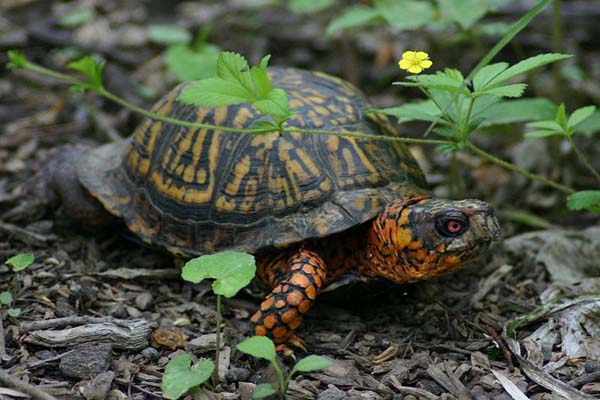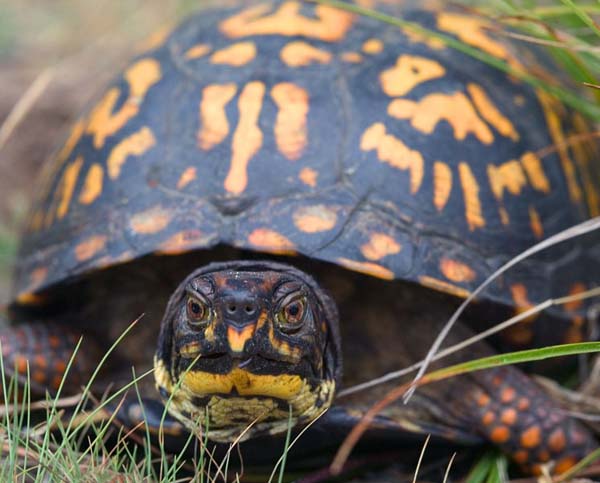Wildlife North America . com North American Animals - mamals, birds, reptiles, insects |
Eastern Box Turtle (Terrapene carolina)
male Eastern Box Turtle Photograph by Branlon. License: Public Domain. (view image details) 
Eastern Box Turtle Photograph by U.S. Fish and Wildlife Service photo. License: Public Domain. (view image details)
EASTERN BOX TURTLE FACTS
DescriptionEastern Box Turtles have a high, dome-like carapace. The carapace is brown or black with yellow or orange pattern of radiating lines, spots or blotches. The skin is usually brown with some yellow, purple or white spots or streaks. Younger turtles are usually more brightly colored than the older turtles. Males usually have red eyes and females usually have brown eyes. Eastern box turtles have a sharp horny beak. The legs are stout with feet webbed only at the base. Males have concave plastron, while females have a flat plastron. Size Length 11cm - 18cm Environment Eastern box turtles prefer deciduous forest or mixed forest with well-drained moist forest floor. Also found in grassland and pastures. Food Eastern Box Turtles eat earthworms, snails, grubs, beetles, caterpillars, grasses, fruit, berries, mushrooms, flowers, leaves, carrion. Breeding Nesting season is from May to July. Nests are dug in sandy or loamy soil, after dusk. The female lays 3-8 oval soft-shelled eggs in the cavity and covers the nest with sand or soil. The young hatch after about three months. The sex of hatchlings is determined by temperature. Nests at 22-27 degrees celsius produce mostly males, nests above 28 degrees produce mainly females. Range The Eastern Box Turtle is found in the eastern United States from southern Maine and the Michigan Upper Peninsula, south to southern Florida and west to eastern Kansas, Oklahoma, and Texas. It is uncommon in the Great Lakes and the Midwest. Notes The Eastern Box Turtle is protected throughout most of its range, although many states allow the capture of box turtles as pets. They are bred in captivity, but thousands are still collected from the wild. They make hardy captive pets, but they can be difficult to keep due to their requirements for high humidity, warm temperatures, suitable substrate for burrowing, and ultraviolet lighting that mimics sunlight. They also may require vitamin supplements to keep them healthy. In captivity they feed on various live invertebrates such as crickets, worms, earthworms, grubs, beetles and larvae, cockroaches, small mice, and fish, berries, fruit, lettuce, dandelion greens and other plants. Conservation Status LR|nt Classification
Relatives in same Genus Desert Box Turtle (T. ornata luteola) Home | Mammals | Reptiles | Birds | Insects | Privacy Policy | Disclaimer | Contact Us |